New Update: Boost Social Proof with Reviews & Automation
New Update: Boost Social Proof with Reviews & Automation
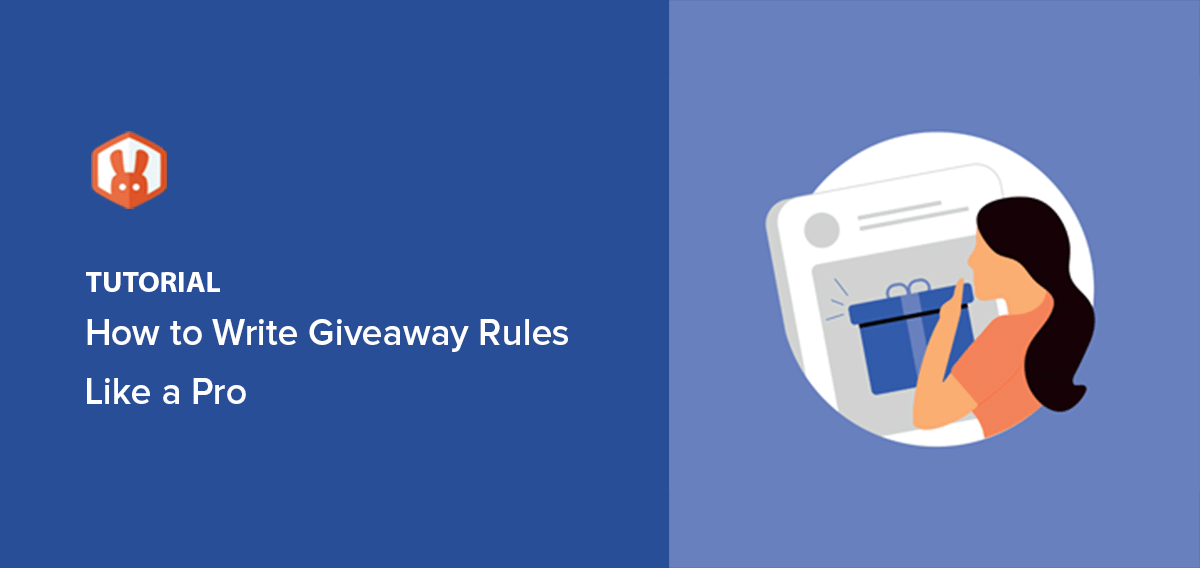
 John Turner
John Turner
 John Turner
John Turner
I’ve seen some amazing giveaways go sideways just because the rules weren’t clear. It might not be the most exciting part of running a promotion, but writing strong giveaway rules is one of the most important.
Rules help you avoid confusion, stay legally protected, and make sure everyone plays fair. In this guide, I’ll walk you through how to write giveaway rules that work, plus examples and tools to make the process easier.
Before we dive into the rules, let’s clear up some terminology. Giveaways, contests, and sweepstakes might sound similar, but they have key differences.
Giveaways are the simplest. They’re free to enter and winners are chosen randomly. Imagine a brand giving away products to random followers who like and share a post.
In this example, you can see that Dunkin’ has kept their initial giveaway post simple, with only the essential information needed to enter:
Contests involve skill or effort. You select winners based on merit. Think of a photo contest where the best entry wins, or a recipe competition judged by chefs.
For example, Bob Books runs a monthly photo contest where winners are decided based on how well they interpret that month’s theme:
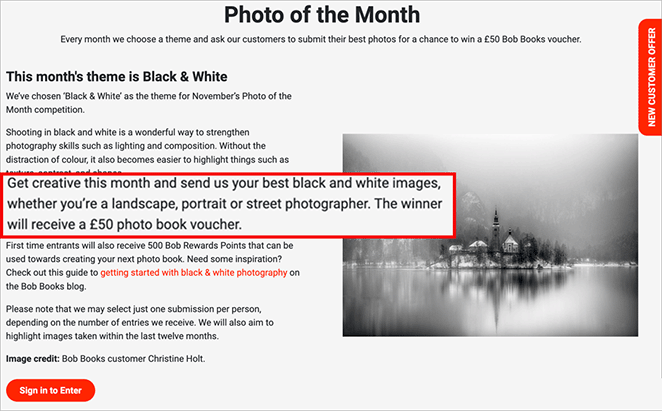
Sweepstakes are like giveaways, but often have more complex rules and bigger prizes. They’re free to enter and winners are selected by chance. “Win a dream vacation” promotions fall into this category.
In fact, that’s exactly what people.com offers in this example:

Knowing these differences helps you create the right rules and stay compliant with regulations. So, before you start writing, make sure you know exactly what type of promotion you’re running.
In the United States, the Federal Trade Commission (FTC) sets the rules for giveaways, contests, and sweepstakes. Their main goal? Keeping things fair and protecting consumers.
One big rule you need to know is “No Purchase Necessary.” This means you can’t make people buy something to enter your giveaway. If you’re selling entries, you must also offer a free way to enter.
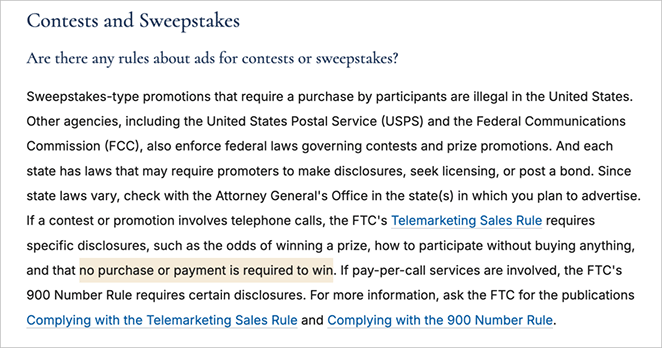
Each state has its own rules, too. New York and Florida, for example, require registration for prizes over a certain value.

And if you’re thinking of going global, be prepared for a whole new set of rules.
For giveaways that might involve EU residents, you need to consider GDPR. This law focuses on protecting personal data. So, make sure you’re clear about how you’ll use entrants’ information.
It might seem like a lot, but don’t let it scare you off. These laws are there to protect both you and your participants. If you’re unsure, it’s always best to check with a legal professional.
For more information, refer to the FTC’s guide on promotions and the GDPR official website.
Giveaway rules should always include:
Make sure your rules match the type of promotion you’re running—whether it’s a giveaway, contest, or sweepstakes.
Writing clear giveaway rules doesn’t have to be complicated. With the right approach, it’s straightforward and sets you up for success.
Before you start writing rules, you need to know exactly what you’re trying to achieve.
Are you looking to:
Whatever your goal, write it down. This will guide every decision you make about your giveaway.
Next, think about who you want to reach. Are you targeting new customers or rewarding loyal ones? Maybe you’re after a specific age group or people with certain interests. Knowing your audience helps you create rules that appeal to them.
Don’t forget to decide how long your giveaway will run. A day, week, month? The duration can affect engagement, so choose wisely.
Lastly, consider where your giveaway will be available. Are you keeping it local, going nationwide, or opening it up globally? Remember, different locations mean different rules to follow.
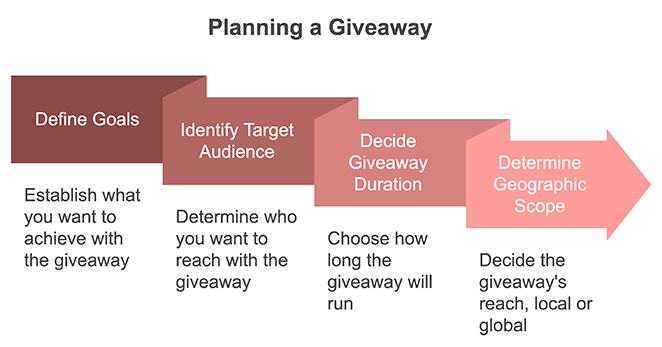
After setting your goals, decide who can join your giveaway. This step helps you prevent confusion and keeps your giveaway compliant.
Start with age restrictions. Clearly state any age limits, stating if your giveaway is for adults only or open to teenagers too.
Next, define the location. Be specific about the boundaries you decided on earlier. Whether it’s for US residents only or worldwide, clarify it.
As you can see in this example, the organizer of the giveaway clearly states that it’s open to UK entries only:
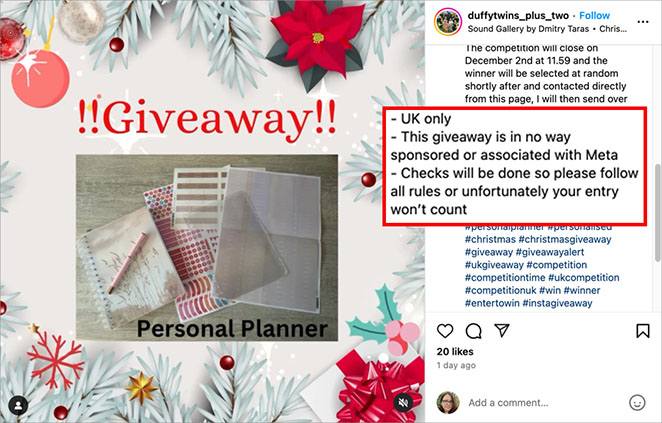
Don’t forget about employees. Preventing your employees and their family members from entering is standard practice. It maintains fairness and avoids any appearance of bias.
Now let’s look at how people can enter your giveaway. This is where you get specific about what participants need to do.
Common entry methods include:
Be clear about each step. For example, instead of saying “follow us on social media,” specify “follow @YourBrand on Instagram and Twitter.”
Mountain Warehouse doesn’t just list their profile, they tag it so it’s easier for users to click and follow them:
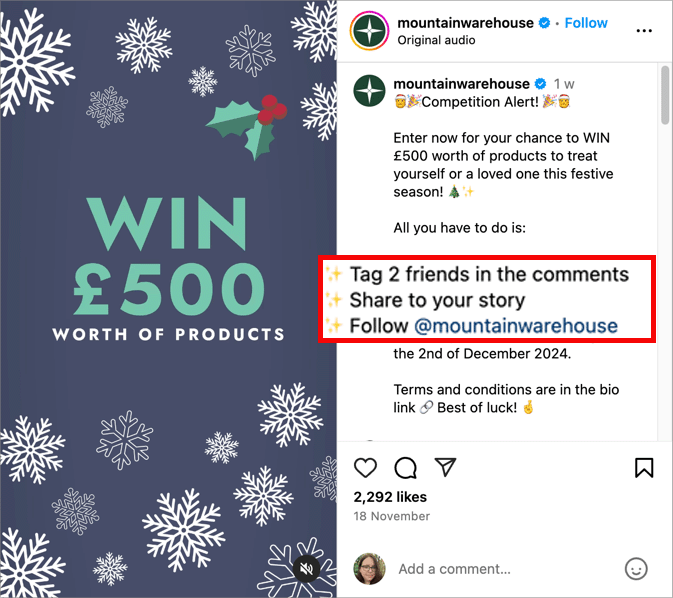
If you’re using multiple entry methods, explain if they’re all required or if each one counts as a separate entry.
Avoid vague instructions. “Enter as many times as you want” could lead to spam. Instead, set clear limits, like “One entry per person per day.”
I particularly like how Birra Moretti uses a dedicated terms and conditions page to clearly outline their requirements. It keeps everything in one place and easy to access:
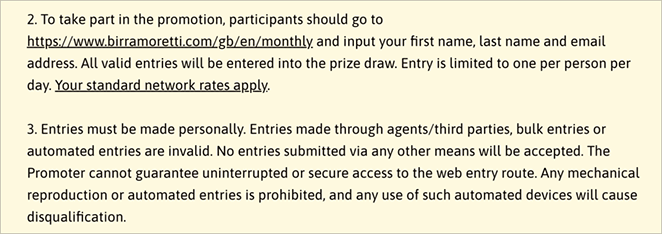
Remember, the easier and clearer your entry method, the more likely people are to participate. But always balance simplicity with your giveaway goals.
Your giveaway prize is what encourages people to enter your giveaway. So, make it shine by writing enticing details.
Start with a description of what you’re giving away. Is it a product, a service, or an experience? Be specific and highlight what makes it valuable.
Include key information like:
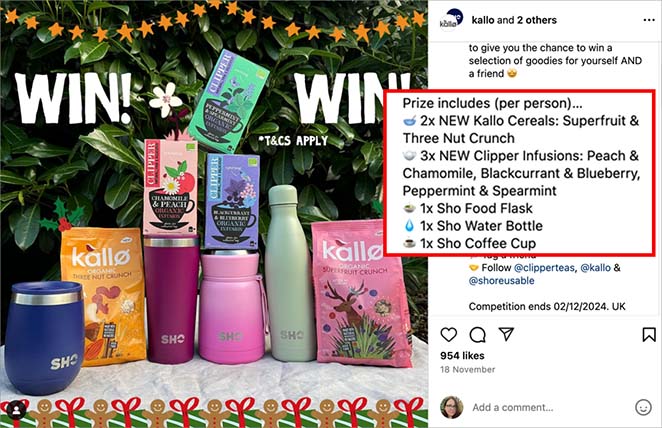
Don’t forget to mention any restrictions. For example, if the prize is a trip, specify if it includes airfare or just accommodation.
Adding high-quality images or videos of the prizes can also increase excitement. People love to see what they might win.
And, if you’re offering multiple prizes, clearly explain how you’ll distribute them. Is there one grand prize and several runner-up giveaway prizes?
Being clear about how you’ll pick giveaway winners is another way to build trust and keeps things fair.
Here’s an idea of what to include:
Set a deadline for claiming prizes. Something like “Winners have 48 hours to respond” works well.

If there’s a chance of ties, explain how you’ll break them. This is especially important for skill-based contests.
Lastly, mention if you’ll pick backup winners. It’s always good to have a Plan B.
The clearer you are now, the smoother things will run later. Plus, it helps avoid any “Hey, that’s not fair!” comments down the line.
Legal disclaimers aren’t exciting, but they’re critical. They protect your giveaway and your business from any problems that may arise. They also make sure everyone knows the rules and help you avoid legal issues.
For instance, you can:
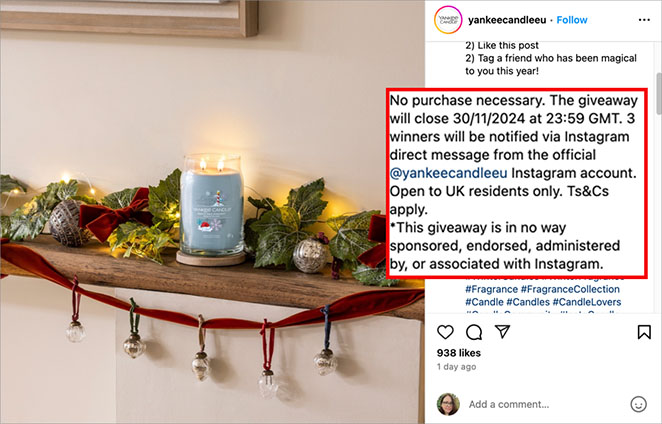
Keep the language simple and clear. And, if you’re not sure about anything, it’s best to ask a lawyer.
You’re almost done. But, before you share your giveaway, take these last steps.
Read through your rules carefully. Look for any mistakes, confusing parts, or missing info. Reading out loud or asking someone else to check can help.
Make sure you’ve included all the key details:
Also, check that your rules match what you wanted to achieve with your giveaway.
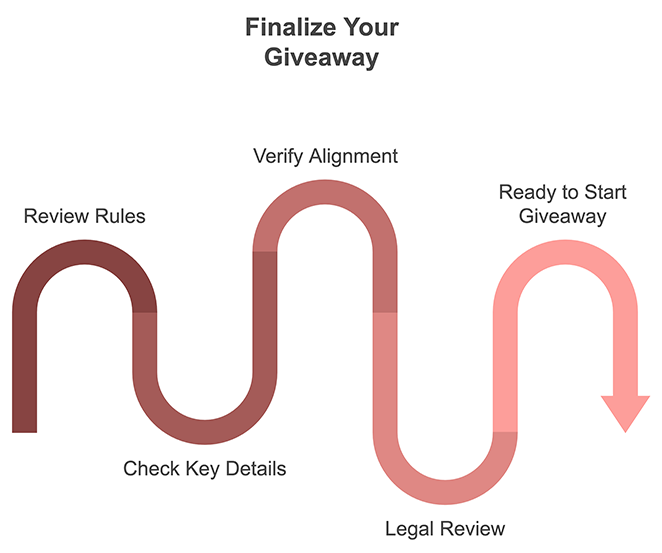
If you can, ask a lawyer to look over your rules. They might spot legal issues you didn’t notice, which can prevent problems later.
When you’re sure everything looks good, you’re ready to start your giveaway.
Creating giveaways can be tricky, but it doesn’t have to be. WordPress giveaway plugins like RafflePress make the whole process easier and help you stay on the right side of the law.

If you intend to run a giveaway on your WordPress website, here’s how RafflePress helps with each step we’ve covered:
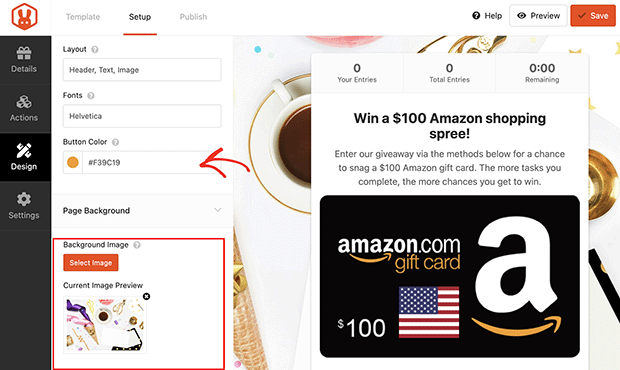
Don’t just take my word for it. Here’s what Scott Gardener, owner of Agile’ Marketing Services, says:
“I’m a huge proponent of using email lists and try to make sure all my clients use them. RafflePress is a fun and easy way to build or add to your list. With just one contest, I added to one client’s list by over 50%.”
With RafflePress, you can focus on the fun part of giveaways, engaging with your audience and growing your business.
Creating clear giveaway rules keeps your campaign fair, users informed, and protects your business.
While writing rules can seem daunting, giveaway tools make the process easier. They help you set up legal giveaways quickly, manage entries efficiently, and select winners fairly.
For more advice on running successful giveaways, see the following guides:
If you liked this article, please subscribe to our YouTube Channel for RafflePress video tutorials. You can also find us on Twitter and Facebook.
Disclosure: Our content is reader-supported. This means if you click on some of our links, then we may earn a commission. We only recommend products that we believe will add value to our readers.
Copyright © 2024 SeedProd LLC. RafflePress® is a registered trademark of SeedProd LLC